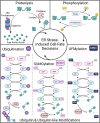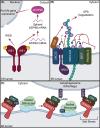Post-translational modifications: emerging directors of cell-fate decisions during endoplasmic reticulum stress in Arabidopsis thaliana
- PMID: 38600022
- PMCID: PMC11088923
- DOI: 10.1042/BST20231025
Post-translational modifications: emerging directors of cell-fate decisions during endoplasmic reticulum stress in Arabidopsis thaliana
Abstract
Homeostasis of the endoplasmic reticulum (ER) is critical for growth, development, and stress responses. Perturbations causing an imbalance in ER proteostasis lead to a potentially lethal condition known as ER stress. In ER stress situations, cell-fate decisions either activate pro-life pathways that reestablish homeostasis or initiate pro-death pathways to prevent further damage to the organism. Understanding the mechanisms underpinning cell-fate decisions in ER stress is critical for crop development and has the potential to enable translation of conserved components to ER stress-related diseases in metazoans. Post-translational modifications (PTMs) of proteins are emerging as key players in cell-fate decisions in situations of imbalanced ER proteostasis. In this review, we address PTMs orchestrating cell-fate decisions in ER stress in plants and provide evidence-based perspectives for where future studies may focus to identify additional PTMs involved in ER stress management.
Keywords: Arabidopsis thaliana; ER stress; UPR; cell-fate; post translational modification; programmed cell death.
© 2024 The Author(s).
Conflict of interest statement
The authors declare that there are no competing interests associated with the manuscript.
Figures






References
Publication types
MeSH terms
Substances
Grants and funding
LinkOut - more resources
Full Text Sources
Miscellaneous

